

Constructing assessment tasks 2016. Formative Assessment and the NGSS. Within this post, I am going to focus on formative assessment as an ongoing assessment conducted as part of daily instruction to guide further instruction.

They are informal or formal checks of knowledge happening in conjunction with instruction. I’m not considering more summative type assessments such as end-of-unit tests or student projects. Though to be sure, all assessments should be formative, in that the results will be used to guide decision-making in relation to instruction. Therefore, formative assessments probably won’t be the primary tools that teachers and administrators will look at when determining whether their school as a whole is making progress toward their vision for science education. Instead, they are tools that will influence daily decisions in the classroom, as well as student and/or teacher collaborative conversations. A fifth grade teacher shows students a large syringe full of air. Educator teams collaboratively define a vision of student learning. The Center on Standards & Assessment Implementation.
The SAIC produced the following guiding documentation that will be used by the 15 participating states—and are available publicly—to inform large-scale NGSS test and item development: An Assessment Framework that includes the overall test design, description of an aligned test item cluster as the foundational unit of an NGSS-aligned assessment, specifications for various types of test items, and accessibility principles;Item Specifications Guidelines that detail a model of NGSS item cluster specifications, classify item types for consideration in an item cluster, identify key elements for each item cluster, and describe the linkage between item clusters and the NGSS;Two Item Cluster Prototypes (Grade 5 and High School) that can be used by the participating states to inform test item development.

. * Next Generation Science Standards (NGSS)® is a registered trademark of Achieve. The Center on Standards & Assessment Implementation. SHORT COURSE: How to Develop 3D Formative Assessments for the Science Classroom : StemTeachingTools. SHORT COURSE: How to Develop 3D Formative Assessments for the Science Classroom Posted on April 05, 2016 This short course will help you learn how to develop and use 3D formative assessments in the classroom.

Background Formative assessment in the classroom is crucial because everyone engaged in complex learning benefits from timely and focused feedback from more expert others. The process also promotes important processes of self-explanation, reflection, and learning. Resources. Steps to Designing a 3-Dimensional Assessment.
OVERVIEW: The Research + Practice Collaboratory continues to provide short, powerful, and easy-to-use tools for the field.

The latest resource from this group is PD Tool: Steps to Designing a 3-Dimensional Assessment. The 5 steps in the process are: Step 1: Define what you will assess by analyzing relevant sections of A Framework for K-12 Science Education and crafting learning claims.Step 2: Brainstorm Possible Scenarios for Eliciting Student Understanding.Step 3: Use Task Formats to Build Questions to Engage Students with the Scenario.Step 4: Imagine the Range of Possible Student Responses to the Questions.Step 5: Share, Review, and Revise. This tool is intended to be a companion to two other great tools: AUDIENCE: Teachers, teacher leaders, PD providers, curriculum directors, administrators, others. Next Generation Science Assessment – Developing NGSS-aligned assessments and curricula for the next generation of K-12 students. STEM Gauge Teachers Guide. System of Assesment Paper 9.30.15. Science Magazine: Sign In. Proficiency in science is being defined through performance expectations that intertwine science practices, cross-cutting concepts, and core content knowledge.
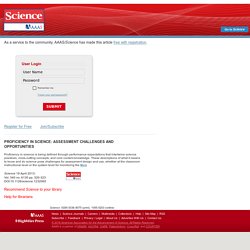
These descriptions of what it means to know and do science pose challenges for assessment design and use, whether at the classroom instructional level or the system level for monitoring the More. Developing Assessments for the Next Generation Science Standards. Science education system, it will be important that they incorporate results from a variety of types of assessments.
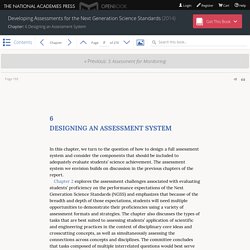
When external, on-demand assessments dominate in an assessment system and are the sole basis for accountability, curriculum and instruction are most likely to become narrowed to reflect only the material and testing formats that are represented on those assessments (Koretz, 2005, 2008). There is very limited evidence that accountability policies to date, which focus largely—if not solely—on external (large-scale) assessments, have led to improved student achievement (National Research Council, 2011b).
In contrast, numerous studies document the positive effects on learning from the use of classroom assessment to guide teaching and learning (Black and Wiliam, 1998; Kingston and Nash, 2011; National Research Council, 2007). Developing Assessments for the Next Generation Science Standards. Problems, and portfolios in writing and mathematics in which students presented the best examples of their classroom work for a school year.
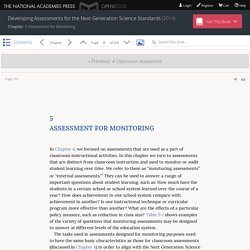
Assessments were given in seven areas: reading, writing, social science, science, math, arts and humanities, and practical living/vocational studies. Scores were reported for individual students. In 1988, Vermont implemented a statewide assessment in mathematics and writing for students in grades 4 and 8 that included two parts: a portfolio component and uniform subject-matter tests. For the portfolio, the tasks were not standardized: teachers and students were given unconstrained choice in selecting the products to be in them.
The portfolios were complemented by subject-matter tests that were standardized and consisted of a variety of item types. The Maryland School Performance Assessment System (MSPAP) was implemented in 1991. Developing Assessments for the Next Generation Science Standards. This example of an assessment task illustrates the concept of three-dimensional science learning, the kinds of instructional experiences that are needed to support its development, and the assessment tasks that can provide documentation of this kind of learning.7 It also shows how a performance expectation can be used to develop an assessment task and the associated scoring rubric.
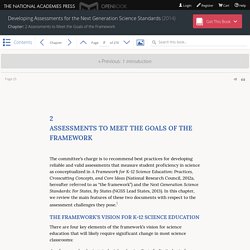
Specifically, it illustrates how students’ classroom investigations yield products that can be used as formative assessments of their understanding of and ability to connect disciplinary core ideas. Instructional Context The curriculum materials for the 7th-grade unit, “What Is Going on Inside Me,” were developed as part of the 3-year middle school curriculum series developed by the Investigating and Questioning our World through Science and Technology (IQWST) project (Krajcik et al., 2008b; Shwartz et al., 2008). 7As noted in Chapter 1, we use examples of assessment tasks to illustrate the discussion. NGSS: Item Cluster Prototypes Grade 5 and HS. The Science Assessment Item Collaborative (SAIC) in partnership with WestEd and CCSSO recently released two sample item clusters for assessment of the Next Generation Science Standards.
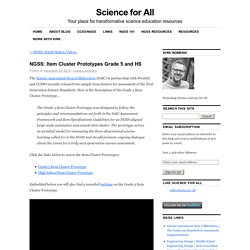
Here is the description of the Grade 5 Item Cluster Prototype… 4.5-Practices-unpacking_examples.pdf. 1_NGSS Forum Slides 2015V3.pdf. Research Brief: Designing an Assessment System that Measures Three-Dimensional Science Learning : StemTeachingTools.